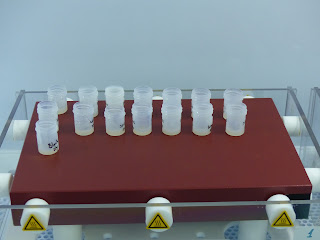In Santa Cruz, I live in a beach town. In Eilat, I work in a beach town. In both places, I spend a good deal of my time in the lab. There are labs, and then there are clean labs. The difference? Well, apart from clean being just what they are (clean), they stay that way by following a laundry list of procedures to keep dust, hair, and lint out of samples (which destroys the data).
In the case of the cleans labs at Santa Cruz and IUI, the main cause of concern is metal. These labs focus on trace metal chemistry meaning that the scientists are studying tiny, tiny, tiny amounts of material containing things like lead, uranium, and thorium. These can exist as minute quantities in many things we use in our daily lives such as steel doors, brass handles, pipes and wires, and electronics. Because of this, clean labs tend to be made almost entirely of plastic.
In addition, the protective equipment I must wear in the lab has two purposes. It keeps lint from my clothes or hair from my head from floating around the lab and contaminating the space, and it protects me from the many types of acid used to study metals. In this picture, I'm wearing a hair net, gloves, and a Tyvek suite which keeps my clothes and body from contaminating samples.
I do all of my work wearing this outfit. As I said, clean labs mostly use plastic, and one of the stars among the plastic world is Teflon. Yep, Teflon, the non-stick coating with which you may be familiar. It's quite a dense plastic, and the non-stick properties are useful when dealing with drops of liquid like those falling out of these columns.
As I add nitric acid to the top of the columns, it slowly drains through the resin and strips out metals I don't want. I can then use another acid, like hydrochloric acid or bromic acid, to take out the thorium and uranium. If the columns weren't made of Teflon, the tension of the water would cause the drops to stick, and I would never get my sample!
Once I have collected the drops in Teflon beakers, I place them on a hotplate to evaporate most of the liquid. All that remains is a tiny, tiny pinpoint of solid that contains my concentrated uranium or thorium. These are the samples I will analyze on a mass spectrometer, an instrument that uses magnets to detect the mass (amount of stuff) in a sample. Remember that every element on the periodic table has a different mass, and each element actually has different varieties, called isotopes, that differ slightly in mass because of the number of neutrons in their nucleus. The magnets affect each mass differently, so when they hit the detector, the instrument knows what it is based on how it traveled through the magnetic field.
Mass spectrometers have revolutionized science, and in particular the earth sciences. They tell me what kind of stuff I'm looking at, and based on the known physical properties of that stuff (like uranium), I can deduce much about the history of a material. Geology is storytelling, and the clean lab offers an exquisite set of tools to read that story.




No comments:
Post a Comment